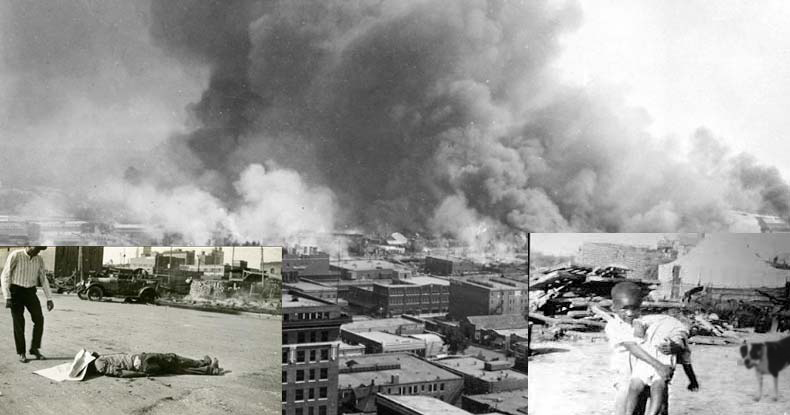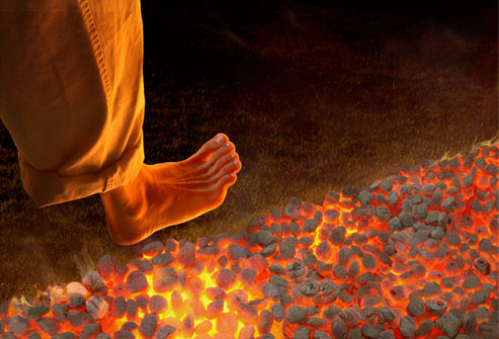It’s the Anniversary of the Worst Terrorist Attack in the US Before 9/11 — And No One’s Heard Of It
May 31, 2016
“Personal belongings and household goods had been removed from many homes and piled in the streets. On the steps of the few houses that remained sat feeble and gray Negro men and women and occasionally a small child. The look in their eyes was one of dejection and supplication. Judging from their attitude, it was not of material consequence to them whether they lived or died. Harmless themselves, they apparently could not conceive the brutality and fiendishness of men who would deliberately set fire to the homes of their friends and neighbors and just as deliberately shoot them down in their tracks,” the Tulsa Daily World described on June 2, 1921, following the obliteration of a thriving neighborhood that had come to be called Black Wall Street.
Prior to the attacks of September 11, 2001, the outright decimation of Black Wall Street, also known as Little Africa — which began the evening of May 31, 1921, and didn’t end until the following afternoon — had been considered the worst act of terrorism on U.S. soil and the worst civil disturbance since the Civil War. Unfortunately, now 95 years later, the tragic annihilation of an entire neighborhood has almost been lost to the passing of time — indeed, the insufficiently-named “Tulsa Riots” have almost wholly vanished from school curriculae outside Oklahoma.
Credible estimates claim up to 400 people lost their lives, over 800 suffered injuries requiring admittance to area hospitals, “an estimated 10,000 were left homeless, 35 city blocks housing 1,256 residences were destroyed, and 600 successful businesses were lost, including 21 restaurants, 30 grocery stores, two movie theaters and a hospital,” the Atlanta Black Star summarized in 2014.
Black Wall Street blossomed in the Greenwood District of Tulsa, as segregation laws — dictating neither white nor black Americans could live in a neighborhood with more than 75 percent population of the other race — ironically created a system which kept money from leaving the community. African-Americans, by law, could not shop in white-owned business, so every imaginable business — from groceries and clothiers to hospitals and theaters — became immensely profitable.
Schools offered superior educational opportunities, and homes and businesses in Little Africa were equipped with indoor plumbing before their white counterparts. An oil boom in the 1910s amplified the growth of the middle class. Greenwood, by all historical accounts, primarily consisted of the middle- and upper-classes — and by the time of the so-called riots, about 10,000 people lived and worked in Little Africa.
As Jim Crow laws increased around the country, the overwhelming success experienced by citizens of Greenwood acerbated nearby white populations. Tensions between those communities reached a boiling point when Dick Rowland, rich from the business of shining shoes, was thrown in jail after being accused of the rape of white elevator operator, Sarah Page.
“While it is still uncertain as to precisely what happened in the Drexel Building on May 30, 1921,” the Oklahoma Historical Society explains, “the most common explanation is that Rowland stepped on Page’s foot as he entered the elevator, causing her to scream.”
An irate lynch mob gathered on the courthouse steps the following evening, calling for Rowland to be handed over; but the sheriff refused. An armed group of about 25 black men, including many World War I veterans, offered to help the sheriff protect Rowland, but were denied.
Later, the furious white mob attempted to break into a National Guard armory, but the effort was thwarted. Chaos continued as a second group of about 75 black men returned to the courthouse — and were again turned away by authorities. As they left, according to the Historical Society, a white man moved to disarm a black vet, causing a shot to be fired into the air. Shortly thereafter, all hell broke loose.
While these events certainly sparked the civilian and law enforcement terror attacks on the affluent neighborhood, the Oklahoma Commission to Study the Tulsa Race Riot of 1921 published a startling finding in its report in February 2001:
At the time, many said that this was no spontaneous eruption of the rabble; it was planned and executed by the elite. Quite a few people — including some members of this commission — have studied the question and are persuaded that this is so, that the Tulsa race riot was the result of a conspiracy.
Though the opinion wasn’t unanimously concluded by the commission, many scholars and historians have argued the same. When examining the details of events variously called race riots and outright terror attacks, the determination that an embittered elite opportunistically enjoined the Ku Klux Klan in seeking to destroy prosperous Black Wall Street handily fills gaps in the account lost over time.
After the shot fired on the courthouse steps, some accounts say the black contingent returned to Greenwood, but generally, the situation in Tulsa devolved into mayhem. Though the sheriff had refused to turn Rowland over to be lynched, Tulsa law enforcement officers deputized a number of people who had comprised the white mob.
Over a period of hours, black Tulsans were randomly victimized and targeted in drive-by shootings; homes and businesses in Little Africa were looted; and a number of fires set to buildings on the perimeter of the neighborhood. Law enforcement simply did not protect the Greenwood neighborhood, nor any of the black population anywhere in Tulsa. Though the National Guard mobilized, ostensibly to stem the increasing atrocities, guard members instead protected white areas of the city against a nonexistent threat.
No body of law enforcement did anything to stop any violence perpetrated by the vicious white mob — and by some accounts, they performed mass arrests of Greenwood’s residents and even carried out atrocities. Little Africa’s tenacious residents defended their community for as long as possible, managing to stave off the hateful crowd for some time.
But by sunrise, hundreds lay siege to Black Wall Street — murdering, looting, and burning everything in sight. At least one machine gun was used. Most accounts of the attack say planes — identified murkily as either flown by police or authorities — repeatedly bombed the area.
By the time the violence ceased, Black Wall Street was effectively decimated — some 40 square blocks burned to the ground. Up to 300 people had been murdered, many buried in unmarked graves. In the time shortly after the riots, Greenwood began to rebuild — though many were forced to endure winter living in tents. Despite relatively successful reconstruction projects, the community never again thrived in quite the same way it had prior to the attack.
Astonishingly, not a single person was ever held accountable for any atrocity committed — not one murder, not one case of arson, not even robbery.
Debate over what actually occurred between Rowland and Page that ultimately led to the terrible events remains a matter of conjecture for two reasons.
First, no written record of Page’s account to police has ever materialized. Second, though the incident appears to be as plain as Rowland having accidentally stomped on Page’s foot, local newspaper the Tulsa Tribune reportedly first characterized it as a rape — though even that report doesn’t exist in hard copy. Microfilmed archives of the paper remain available, but according to the Commission’s report, “before the actual microfilming was done some years later, someone had deliberately torn out of the May 31, 1921 city edition both a front-page article and, in addition, nearly all of the editorial page.”
While those aspects might appear to be superficial details, they lend a degree of credibility to the idea the entire riot and subsequent destruction of Black Wall Street had been a carefully orchestrated plot.
Perhaps the greatest threat Black Wall Street posed to the elites — considering the Tulsa riots occurred during the historical period of ‘robber barons,’ monopolies, and economic stratification rivaled only today — wasn’t as much the neighborhood’s racial composition. Maybe, Black Wall Street’s insular and prosperous economy — a neighborhood thriving on its own accomplishments apart from the community and nation at large — constituted the larger menace to the aristocracy.
Though it’s reasonable to assume we will never definitively know every detail leading up to and surrounding the events of May 31 through June 1, 1921, it’s imperative not to allow the attacks to be lost to the passing of time.
http://www.activistpost.com/2016/05/worst-terrorist-attack-before-911.html










 ?
?




